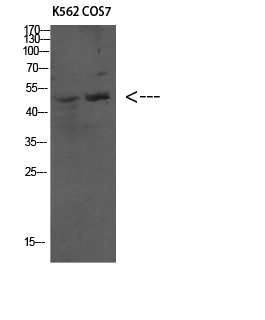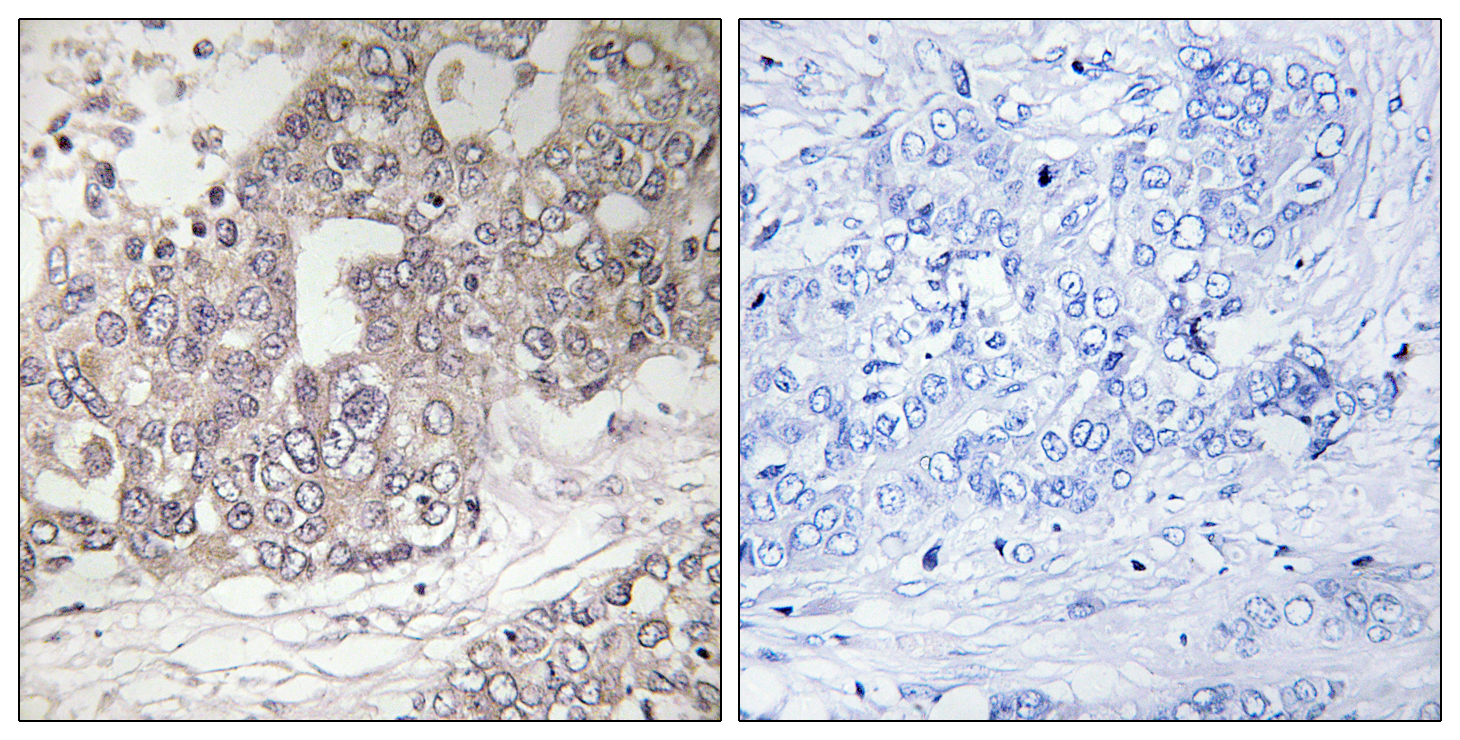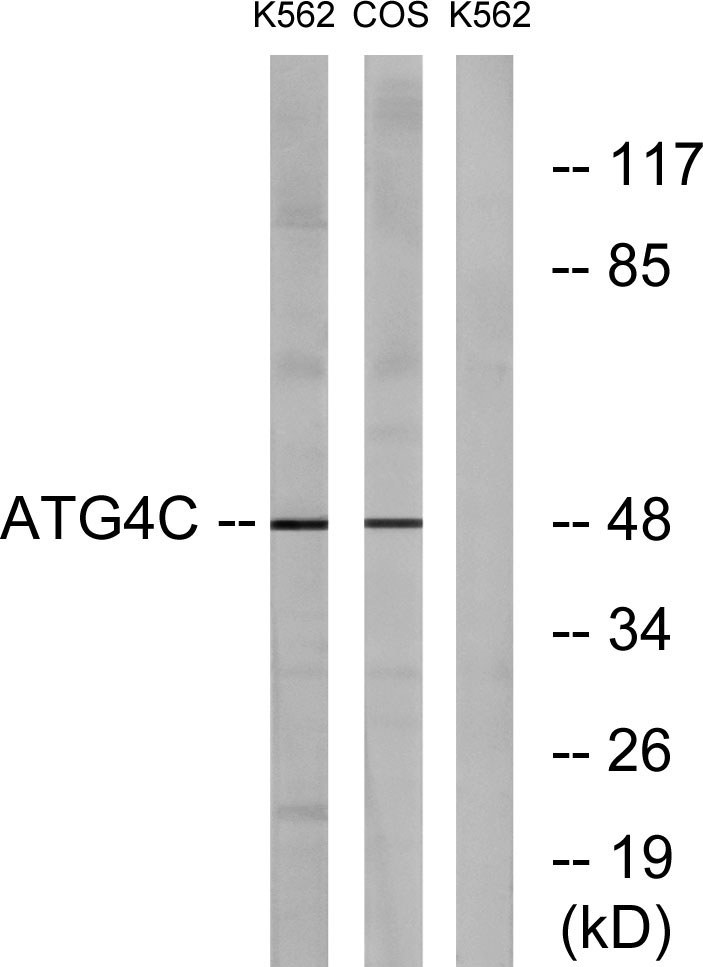Atg4C Polyclonal Antibody
- Catalog No.:YT0395
- Applications:WB;IHC;IF;ELISA
- Reactivity:Human;Monkey
- Target:
- Atg4C
- Fields:
- >>Autophagy - other;>>Autophagy - animal
- Gene Name:
- ATG4C
- Protein Name:
- Cysteine protease ATG4C
- Human Gene Id:
- 84938
- Human Swiss Prot No:
- Q96DT6
- Mouse Swiss Prot No:
- Q811C2
- Immunogen:
- The antiserum was produced against synthesized peptide derived from human ATG4C. AA range:21-70
- Specificity:
- Atg4C Polyclonal Antibody detects endogenous levels of Atg4C protein.
- Formulation:
- Liquid in PBS containing 50% glycerol, 0.5% BSA and 0.02% sodium azide.
- Source:
- Polyclonal, Rabbit,IgG
- Dilution:
- WB 1:500 - 1:2000. IHC 1:100 - 1:300. IF 1:200 - 1:1000. ELISA: 1:20000. Not yet tested in other applications.
- Purification:
- The antibody was affinity-purified from rabbit antiserum by affinity-chromatography using epitope-specific immunogen.
- Concentration:
- 1 mg/ml
- Storage Stability:
- -15°C to -25°C/1 year(Do not lower than -25°C)
- Other Name:
- ATG4C;APG4C;AUTL1;AUTL3;Cysteine protease ATG4C;AUT-like 3 cysteine endopeptidase;Autophagin-3;Autophagy-related cysteine endopeptidase 3;Autophagy-related protein 4 homolog C
- Observed Band(KD):
- 49kD
- Background:
- Autophagy is the process by which endogenous proteins and damaged organelles are destroyed intracellularly. Autophagy is postulated to be essential for cell homeostasis and cell remodeling during differentiation, metamorphosis, non-apoptotic cell death, and aging. Reduced levels of autophagy have been described in some malignant tumors, and a role for autophagy in controlling the unregulated cell growth linked to cancer has been proposed. This gene encodes a member of the autophagin protein family. The encoded protein is also designated as a member of the C-54 family of cysteine proteases. Alternate transcriptional splice variants, encoding the same protein, have been characterized. [provided by RefSeq, Jul 2008],
- Function:
- enzyme regulation:Inhibited by N-ethylmaleimide.,function:Cysteine protease required for autophagy, which cleaves the C-terminal part of either MAP1LC3, GABARAPL2 or GABARAP, allowing the liberation of form I. A subpopulation of form I is subsequently converted to a smaller form (form II). Form II, with a revealed C-terminal glycine, is considered to be the phosphatidylethanolamine (PE)-conjugated form, and has the capacity for the binding to autophagosomes.,similarity:Belongs to the peptidase C54 family.,tissue specificity:Highly expressed in skeletal muscle, heart, liver and testis.,
- Subcellular Location:
- Cytoplasm .
- Expression:
- Brain,Heart,Placenta,Testis,
- June 19-2018
- WESTERN IMMUNOBLOTTING PROTOCOL
- June 19-2018
- IMMUNOHISTOCHEMISTRY-PARAFFIN PROTOCOL
- June 19-2018
- IMMUNOFLUORESCENCE PROTOCOL
- September 08-2020
- FLOW-CYTOMEYRT-PROTOCOL
- May 20-2022
- Cell-Based ELISA│解您多样本WB检测之困扰
- July 13-2018
- CELL-BASED-ELISA-PROTOCOL-FOR-ACETYL-PROTEIN
- July 13-2018
- CELL-BASED-ELISA-PROTOCOL-FOR-PHOSPHO-PROTEIN
- July 13-2018
- Antibody-FAQs
- Products Images

- Western Blot analysis of various cells using Antibody diluted at 1:1000. Secondary antibody(catalog#:RS0002) was diluted at 1:20000

- Immunofluorescence analysis of HUVEC cells, using ATG4C Antibody. The picture on the right is blocked with the synthesized peptide.

- Immunohistochemistry analysis of paraffin-embedded human liver carcinoma tissue, using ATG4C Antibody. The picture on the right is blocked with the synthesized peptide.

- Western blot analysis of lysates from K562 and COS7 cells, using ATG4C Antibody. The lane on the right is blocked with the synthesized peptide.



